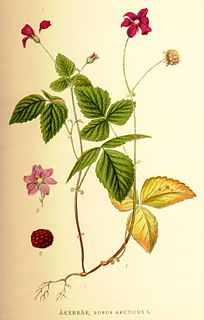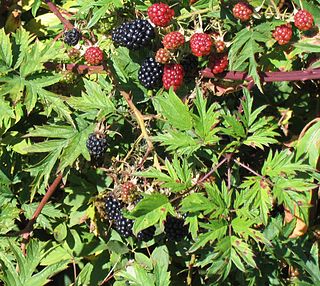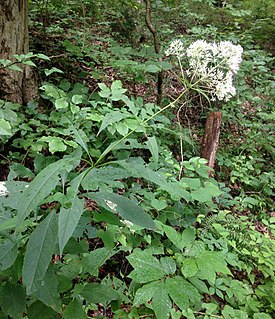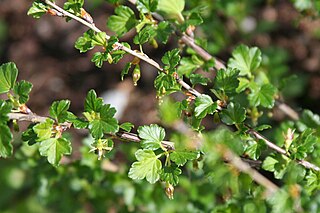
Rubus caesius is a Eurasian species of dewberry, known as the European dewberry. Like other dewberries, it is a species of flowering plant in the rose family, related to the blackberry. It is widely distributed across much of Europe and Asia from Ireland and Portugal as far east as Xinjiang Province in western China. It has also become sparingly naturalized in scattered locations in Argentina, Canada, and the United States.

Rubus arcticus, the Arctic bramble or Arctic raspberry, is a species of slow-growing bramble belonging to the rose family, found in arctic and alpine regions in the Northern Hemisphere.

Rubus laciniatus, the cutleaf evergreen blackberry or evergreen blackberry, is a species of Rubus, native to Eurasia. It is an introduced species in Australia and North America. It has become a weed and invasive species in forested habitats in the United States and Canada, particularly in the Northeast and along the Pacific Coast.

Rubus deliciosus is a North American species of flowering plant in the rose family Rosaceae, native to the United States. Common names include the delicious raspberry, boulder raspberry, Rocky Mountain raspberry or snowy bramble.

Solidago juncea, the early goldenrod, plume golden-rod, or yellow top, is a North American species of herbaceous perennial plants of the sunflower family native to eastern and central Canada and eastern and central United States. It grows from Nova Scotia west to Manitoba and Minnesota south as far as northern Georgia and northern Arkansas, with a few isolated populations in Louisiana and Oklahoma.

Rubus armeniacus, the Himalayan blackberry or Armenian blackberry, is a species of Rubus in the blackberry group Rubus subgenus Rubus series Discolores Focke. It is native to Armenia and Northern Iran, and widely naturalised elsewhere. Both its scientific name and origin have been the subject of much confusion, with much of the literature referring to it as either Rubus procerus or Rubus discolor, and often mistakenly citing its origin as western European. Flora of North America, published in 2014, considers the taxonomy unsettled, and tentatively uses the older name Rubus bifrons.

Eutrochium purpureum, commonly known as purple Joe-Pye weed or sweetscented joe pye weed, is an herbaceous perennial plant in the sunflower family. It is native to eastern and central North America, from Ontario east to New Hampshire and south as far as Florida, Louisiana, and Oklahoma.

Quercus buckleyi, commonly known as Texas red oak or Buckley's oak, is a species of flowering plant in the beech family. It is endemic to the southern Great Plains of the United States.

Rubus pubescens is a herbaceous perennial widespread across much of Canada and the northern United States, from Alaska to Newfoundland, south as far as Oregon, Colorado, and West Virginia.

Rubus illecebrosus is a red-fruited species of Rubus that originally came from Japan, but is also very popular in some European countries like Lithuania. Common names include balloon berry and strawberry raspberry. It has become sparingly naturalized in scattered locations in Canada, the United States, and South America.

Rubus allegheniensis is a species of bramble, known as Allegheny blackberry and simply as common blackberry. Like other blackberries, it is a species of flowering plant in the rose family. It is very common in eastern and central North America. It is also naturalized in a few locations in California and British Columbia.
Rubus aboriginum is a North American species of dewberry, known as the garden dewberry and aboriginal dewberry. Like other dewberries, it is a species of flowering plant in the rose family, related to the blackberry. It is native to the United States and Mexico, primarily in the southern Great Plains with additional populations scattered in the eastern United States and in Nuevo León.

Cardamine angustata is a perennial forb native to the eastern United States, that produces white to pink or purple flowers in early spring.

Solidago ptarmicoides, the prairie goldenrod, white flat-top goldenrod or upland white aster, is a North American perennial flowering plant in the sunflower family. It is native to the central and eastern Canada and parts of the United States (mostly Great Lakes region, the Northeast, the Ozarks, and the northern Great Plains, with isolated populations in Wyoming, Colorado, Oklahoma, and scattered locations in the Southeast. It has also been called upland white solidago, upland white goldenrod, and sneezewort goldenrod
Rubus alumnus, the oldfield blackberry, is a North American species of flowering plant in the rose family. It is native to eastern and central Canada and the eastern and central United States.
Rubus arvensis, the field blackberry, is an uncommon North American species of flowering plant in the rose family. It is found in scattered locations in the southeastern and south-central United States.
Rubus deamii, common name Deam's dewberry, is an uncommon North American species of flowering plant in the rose family. It grows in scattered locations in the east-central United States and southern Canada, from Ontario south to Missouri, Tennessee, and West Virginia, but nowhere is it very common.
Rubus setosus, the bristly blackberry, is a North American species of flowering plant in the rose family. It is widespread in much of central and eastern Canada and the northeastern and north-central United States

Ribes rotundifolium is a North American species of currant known by the common names wild gooseberry and Appalachian gooseberry. It is native to the eastern United States, primarily the Adirondacks, from Massachusetts and the Appalachian Mountains south as far as South Carolina and Tennessee.

Quercus sinuata is a North American species of oak comprising two distinct varieties, Quercus sinuata var. sinuata and Quercus sinuata var. breviloba. Morphologically intermediate forms may occur where range overlap brings the two taxa together. Quercus sinuata var. breviloba is native to central and north central Texas, south central and southwest Oklahoma, and to Coahuila, Nuevo León, and Tamaulipas in northern Mexico. Quercus sinuata var. sinuata is native to the south-central and southeastern United States from central Texas and southwestern Arkansas to the Carolinas. Their respective ranges intersect in the Hill Country of central Texas, where streams flowing through dry, brushy limestone hills create a mosaic of wet and well drained habitats.















